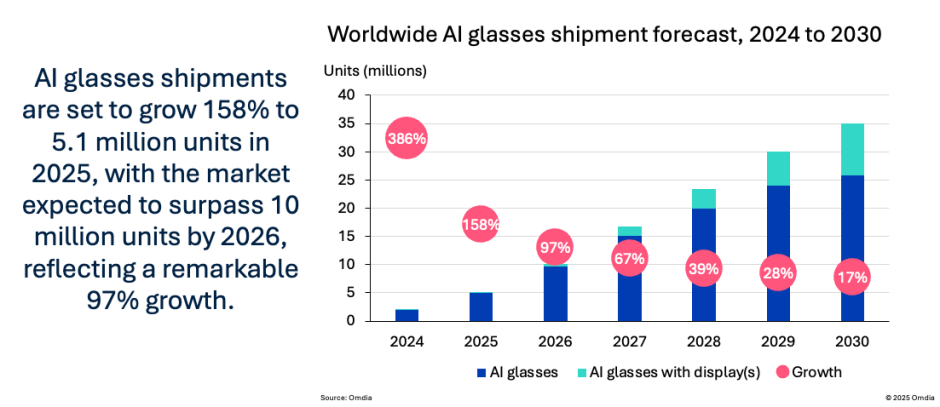The AI glasses market is gearing up for explosive growth, with global shipments forecast to soar 158 percent to 5.1 million units in 2025, according to Omdia. The surge will continue as shipments top 10 million units by 2026 and climb to 35 million units by 2030, representing a remarkable 47 percent compound annual growth rate (CAGR) between 2025 and 2030.

For consumers, AI glasses promise to bring real-time translation, hands-free assistance, and contextual information into daily life. “Integrating intelligence into everyday eyewear could transform the way we experience daily life,” Omdia Research Director Jason Low said in a report. But Jason Low warned that privacy concerns around built-in cameras and microphones, along with social hesitation to wear smart glasses all day, may slow widespread adoption at first.
Consumer-Focused Innovations from Leading Vendors
Meta is setting the pace by expanding its partnership with EssilorLuxottica and Ray-Ban, giving consumers a fashionable option that combines advanced AI features with global distribution.
Google is preparing a new generation of smart glasses powered by on-device large language models, designed for instant translation, visual search, and seamless contextual help.
Xiaomi is integrating its AI eyewear with its smartphone and AIoT ecosystem to offer competitive pricing and easy connectivity for budget-conscious buyers.
Chinese internet leaders Baidu and Tencent are adding generative AI to their prototypes, focusing on entertainment, productivity, and navigation, while Nreal is pushing lightweight designs and AR overlays for comfort and all-day wear.
Rising Demand in Key Markets
The United States will remain the largest market, but China is expected to become the second largest by 2026, shipping 1.2 million units and capturing 12 percent of global share. Strong participation from major tech companies and rapid commercialization of generative AI are laying the groundwork for swift consumer adoption.
Omdia defines AI glasses as head-worn devices using on-device or cloud-based AI models to deliver context-aware assistance through voice and vision interfaces. These capabilities mean users can receive audio responses or subtle visual overlays that adapt to their surroundings, making daily tasks easier and more immersive.
With heavy investment from Meta, Google, Xiaomi, and other innovators, consumers can expect AI glasses to evolve from niche gadgets to essential everyday companions, blending style, practicality, and cutting-edge AI for a truly hands-free digital experience.
Baburajan Kizhakedath
